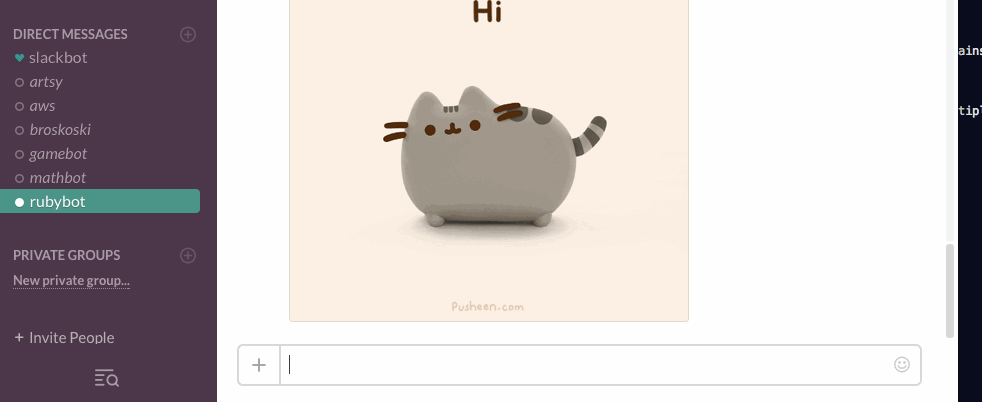|
|
9 years ago | |
|---|---|---|
| .. | ||
| examples | 9 years ago | |
| lib | 9 years ago | |
| screenshots | 9 years ago | |
| spec | 9 years ago | |
| .gitignore | 9 years ago | |
| .rspec | 9 years ago | |
| .rubocop.yml | 9 years ago | |
| .rubocop_todo.yml | 9 years ago | |
| .travis.yml | 9 years ago | |
| CHANGELOG.md | 9 years ago | |
| CONTRIBUTING.md | 9 years ago | |
| DEPLOYMENT.md | 9 years ago | |
| Gemfile | 9 years ago | |
| LICENSE.md | 9 years ago | |
| README.md | 9 years ago | |
| RELEASING.md | 9 years ago | |
| Rakefile | 9 years ago | |
| TUTORIAL.md | 9 years ago | |
| UPGRADING.md | 9 years ago | |
| slack-ruby-bot.gemspec | 9 years ago | |
README.md
Slack-Ruby-Bot
A generic Slack bot framework written in Ruby on top of slack-ruby-client. This library does all the heavy lifting, such as message parsing, so you can focus on implementing slack bot commands. It also attempts to introduce the bare minimum number of requirements or any sorts of limitations. It's a Slack bot boilerplate.
Usage
A Minimal Bot
Gemfile
source 'http://rubygems.org'
gem 'slack-ruby-bot'
pongbot.rb
require 'slack-ruby-bot'
module PongBot
class App < SlackRubyBot::App
end
class Ping < SlackRubyBot::Commands::Base
command 'ping' do |client, data, _match|
client.message text: 'pong', channel: data.channel
end
end
end
PongBot::App.instance.run
After registering the bot, run with SLACK_API_TOKEN=... bundle exec ruby pongbot.rb. Have the bot join a channel and send it a ping.
A Production Bot
A typical production Slack bot is a combination of a vanilla web server and a websocket application that talks to the Slack Real Time Messaging API. See our Writing a Production Bot tutorial for more information.
More Involved Examples
The following examples of production-grade bots based on slack-ruby-bot are listed in growing order of complexity.
- slack-mathbot: Slack integration with math.
- slack-google-bot: A Slack bot that searches Google, including CSE.
- slack-aws: Slack integration with Amazon Web Services.
- slack-gamebot: A generic game bot for ping-pong, chess, etc.
Commands and Operators
Bots are addressed by name, they respond to commands and operators. By default a command class responds, case-insensitively, to its name. A class called Phone that inherits from SlackRubyBot::Commands::Base responds to phone and Phone and calls the call method when implemented.
class Phone < SlackRubyBot::Commands::Base
command 'call'
def self.call(client, data, _match)
send_message client, data.channel, 'called'
end
end
To respond to custom commands and to disable automatic class name matching, use the command keyword. The following command responds to call and 呼び出し (call in Japanese).
class Phone < SlackRubyBot::Commands::Base
command 'call'
command '呼び出し'
def self.call(client, data, _match)
send_message client, data.channel, 'called'
end
end
You can combine multiple commands and use a block to implement them.
class Phone < SlackRubyBot::Commands::Base
command 'call', '呼び出し' do |client, data, _match|
send_message client, data.channel, 'called'
end
end
Command match data includes match['bot'], match['command'] and match['expression']. The bot match always checks against the SlackRubyBot::Config.user and SlackRubyBot::Config.user_id values obtained when the bot starts.
Operators are 1-letter long and are similar to commands. They don't require addressing a bot nor separating an operator from its arguments. The following class responds to =2+2.
class Calculator < SlackRubyBot::Commands::Base
operator '=' do |_data, _match|
# implementation detail
end
end
Operator match data includes match['operator'] and match['expression']. The bot match always checks against the SlackRubyBot::Config.user setting.
Bot Aliases
A bot will always respond to its name (eg. rubybot) and Slack ID (eg. @rubybot), but you can specify multiple aliases via the SLACK_RUBY_BOT_ALIASES environment variable or via an explicit configuration.
SLACK_RUBY_BOT_ALIASES=:pp: table-tennis
SlackRubyBot.configure do |config|
config.aliases = [':pong:', 'pongbot']
end
This is particularly fun with emoji.
Bots also will respond to a direct message, with or without the bot name in the message itself.
Generic Routing
Commands and operators are generic versions of bot routes. You can respond to just about anything by defining a custom route.
class Weather < SlackRubyBot::Commands::Base
match /^How is the weather in (?<location>\w*)\?$/ do |client, data, match|
send_message client, data.channel, "The weather in #{match[:location]} is nice."
end
end
SlackRubyBot::Commands::Base Functions
send_message(client, channel, text)
Send text using a RealTime client to a channel.
send_message_with_gif(client, channel, text, keyword)
Send text along with a random animated GIF based on a keyword.
send_gif(client, channel, keyword)
Send a random animated GIF based on a keyword.
Built-In Commands
Slack-ruby-bot comes with several built-in commands. You can re-define built-in commands, normally, as described above.
[bot name]
This is also known as the default command. Shows bot version and links.
[bot name] hi
Politely says 'hi' back.
[bot name] help
Get help.
Hooks
Hooks are event handlers and respond to Slack RTM API events, such as hello or message. You can implement your own by extending SlackRubyBot::Hooks::Base.
For example, the following hook handles user_change, an event sent when a team member updates their profile or data. This can be useful to update the local user cache when a user is renamed.
module MyBot
module Hooks
module UserChange
extend SlackRubyBot::Hooks::Base
def user_change(client, data)
# data['user']['id'] contains the user ID
# data['user']['name'] contains the new user name
...
end
end
end
end
RSpec Shared Behaviors
Slack-ruby-bot ships with a number of shared RSpec behaviors that can be used in your RSpec tests. Require 'slack-ruby-bot/rspec' in your spec_helper.rb.
- behaves like a slack bot: A bot quacks like a Slack Ruby bot.
- respond with slack message: The bot responds with a message.
- respond with error: An exception is raised inside a bot command.
Contributing
See CONTRIBUTING.
Upgrading
See CHANGELOG for a history of changes and UPGRADING for how to upgrade to more recent versions.
Copyright and License
Copyright (c) 2015, Daniel Doubrovkine, Artsy and Contributors.
This project is licensed under the MIT License.





